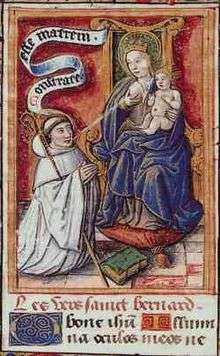Nursing Madonna

The Nursing Madonna, Virgo Lactans, or Madonna Lactans, is an iconography of the Madonna and Child in which the Virgin Mary is shown breastfeeding the infant Jesus.
The depiction is mentioned by Pope Gregory the Great, and a mosaic depiction probably of the 12th century is on the facade of Santa Maria in Trastevere in Rome, though few other examples survive from before the late Middle Ages. It continued to be found in Orthodox icons (as Galaktotrophousa in Greek, Mlekopitatelnitsa in Russian), especially in Russia.[1]
Usage of the depiction seems to have revived with the Cistercian Order in the 12th century, as part of the general upsurge in Marian theology and devotion. Milk was seen as "processed blood", and the milk of the Virgin to some extent paralleled the role of the Blood of Christ.[2]
In the Middle Ages, the middle and upper classes usually contracted breastfeeding out to wetnurses, and the depiction of the Nursing Madonna was linked with the Madonna of Humility, a depiction that showed the Virgin in more ordinary clothes than the royal robes shown, for instance, in images of the Coronation of the Virgin, and often seated on the ground. The appearance of a large number of such depictions in Tuscany in the early 14th century was something of a visual revolution for the theology of the time, compared to the Queen of Heaven depictions; they were also popular in Iberia. After the Council of Trent in the mid-16th century, clerical writers discouraged nudity in religious subjects, and the use of the Madonna Lactans iconography began to fade away.[3]
Another type of depiction, also deprecated after Trent, showed Mary baring her breast in a traditional gesture of female supplication to Christ when asking for mercy for sinners in Deesis or Last Judgement scenes. A good example is the fresco at S. Agostino in San Gimignano, by B. Gozzoli, painted to celebrate the end of the plague.
Lactatio

A variant, known as the Lactation of St Bernard (Lactatio Bernardi in Latin, or simply Lactatio) is based on a miracle or vision concerning St Bernard of Clairvaux where the Virgin sprinkled milk on his lips (in some versions he is awake, praying before an image of the Madonna, in others asleep).[4] In art he usually kneels before a Madonna Lactans, and as Jesus takes a break from feeding, the Virgin squeezes her breast and he is hit with a squirt of milk, often shown travelling an impressive distance. The milk was variously said to have given him wisdom, shown that the Virgin was his mother (and that of mankind generally), or cured an eye infection. In this form the Nursing Madonna survived into Baroque art.
References
- ↑ Tradigo, Alfredo (2006). Icons And Saints of the Eastern Orthodox Church, A Guide to Imagery. Getty. p. 183. ISBN 9780892368457.
- ↑ Saxon, Elizabeth (2006). The Eucharist in Romanesque France: Iconography And Theology. Boydell. pp. 205–207. ISBN 9781843832560.
- ↑ Hinsdale, Mary Ann; Dugan, Kate; Owens, Jennifer (2009). From the Pews in the Back. p. 102. ISBN 0-8146-3258-0.
- ↑ Dewez, Léon; van Iterson, Albert (1956). "La lactation de saint Bernard: Legende et iconographie". Citeaux in de Nederlanden. 7: 165–89.
| Wikimedia Commons has media related to Madonna lactans. |